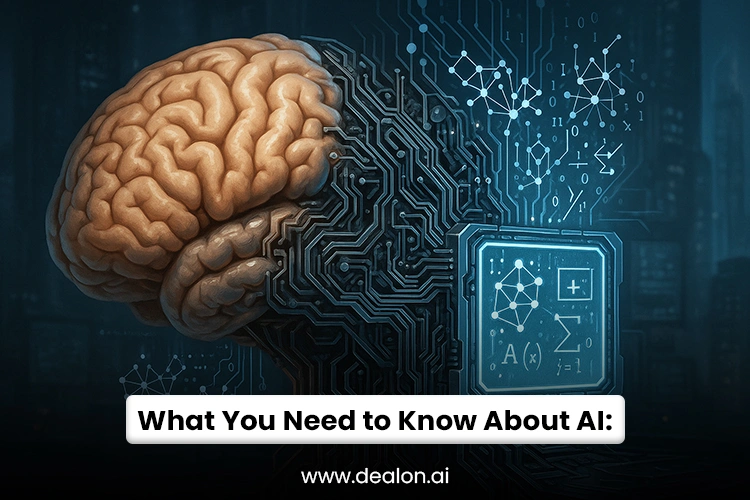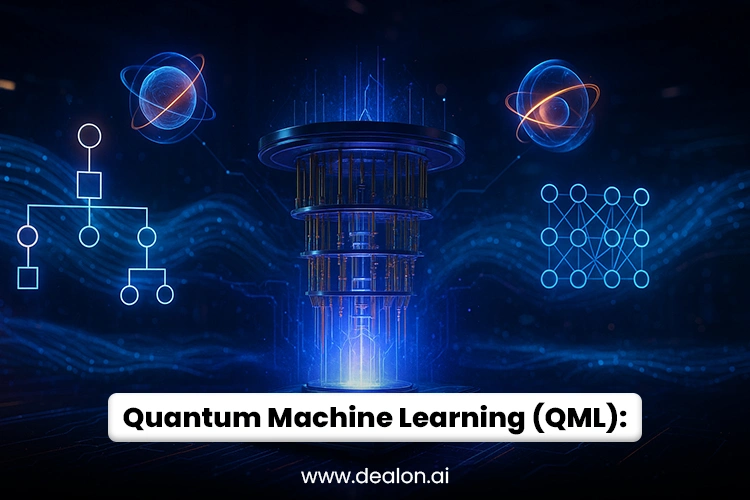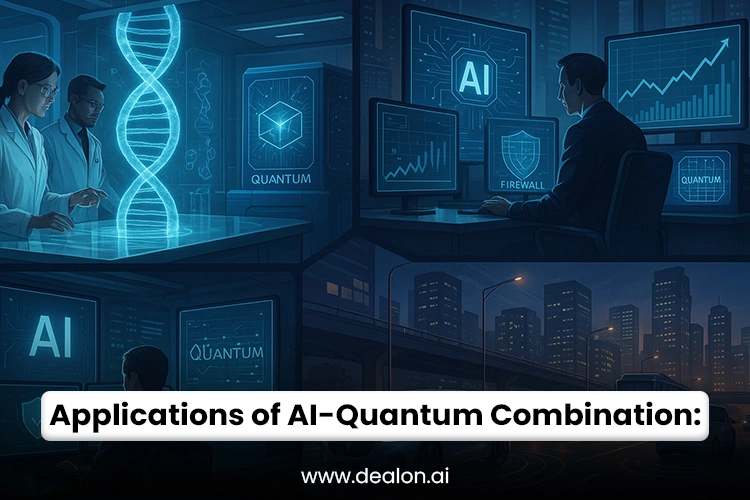AI and quantum computing are joining forces to change how digital innovation is built. Instead of being restricted to specialist talks in universities, this meeting launches a new era in computing that may influence intelligence, computing strength, and global solutions. Artificial intelligence makes significant progress in healthcare, finance, logistics, and others by learning fast, adjusting, and making wise decisions.
However, what quantum computing can truly do is still stopped by the limits of classical computing. With the advent of quantum computing, scientists now open up new possibilities by exploiting things like superposition, entanglement, and quantum tunneling, which challenge how we traditionally look at computing. With these principles, quantum systems handle much larger data and run several operations simultaneously, opening the door to answers to problems considered tough before.
The combination of AI with quantum technology leads to something unique—the incredible processing advantage of quantum makes machine learning more effective. Thanks to this union, discovering drugs can happen faster, languages are translated in real time everywhere, people receive healthcare that fits them perfectly and climate predictions are reliable over longer periods.
Furthermore, the change here is deep-seated, affecting how we approach intelligence, read and analyze data, and work with computers. AI and quantum computing are combining now, not just a future idea. As these innovative fields come together, they hope to help us find quicker solutions and also rethink what questions we ask. The current era means companies must make quantum advances, not just incremental ones.
Also Read: 6 Ways AI is Revolutionizing Personalized Customer Rewards Programs in Retail
What You Need to Know About Artificial Intelligence

AI is the field where machines are programmed to copy human ways of thinking and choosing using much information. Algorithms allow AI systems to understand and predict patterns and outcomes and improve tasks that humans once managed. Generally, AI relies on conventional machines for linear processing, meaning algorithms run sequentially and predictably.
Many people use this approach for virtual assistants and for working with data analytics. Although datasets are getting bigger and more challenging, age systems have trouble scaling up what they do. What used to be straightforward, such as using deep neural networks on big data or running real-time predictive analysis, is now quite time-consuming. Classical computing is not keeping up when deciding in real-time in self-driving cars or for AI models like GPT-3, which use many computing resources.
Quantum computing plays a role here, not simply as a rival, but rather by enhancing and improving AI. While classical computing does things serially, using two states known as bits, quantum computing takes advantage of quantum mechanics to perform many calculations simultaneously. Because it can tackle significant issues faster, quantum computing allows AI to get around its scaling issues. AI and quantum computing combined bring a time when machines have intelligence beyond people and a greater ability to act independently, letting them do more than previous systems.
The Convergence: Why Artificial Intelligence and Quantum Computing Should Go Hand in Hand
It is practically certain that Artificial Intelligence (AI) and quantum computing will be combined because of a growing need for speedy information processing. With the approaching evolution in AI, models need to grow in their ability to manage massive and detailed datasets. These models, including deep neural networks and GANs, are computationally expensive for real-time training, optimizing, and running jobs. Even so, these growing demands are now testing the limits of classical computing systems.
Quantum mechanics, represented by superposition, entanglement, and quantum tunneling, make quantum computing a valuable solution. At the same time, quantum systems explore various algorithmic paths, allowing them to move much more quickly toward identifying the best solutions and overcoming the obstacles that slow down traditional systems.
By running parallel computations, quantum processors lower the time it takes to train and enhance AI models. Deep learning models need this the most since processing time increases fast as the model becomes more complex. Quantum computing makes it possible for AI to use much less energy. Using quantum methods to address high-dimension machine learning issues lowers the need for excessive computer resources, making AI more eco-friendly.
Storing and working with big, unstructured data sets is much better done with quantum computers than with regular computers. Using quantum-enhanced improvements will significantly improve the performance of algorithms that operate on challenging data types in NLP and computer vision. Many AI tasks are nonlinear, such as spotting the best fit in a regression model or properly setting up a neural network through training. These algorithms work naturally with these issues as they are optimized for working in large solutions.
Quantum Machine Learning (QML): Driving a Major Shift in Technology and Innovation

Combining quantum mechanics and machine learning makes QML the most advanced computational approach. The aim here is to make current machine learning faster, more efficient, and even more effective at solving complex problems by bringing in the abilities of quantum computers. As AI models become more advanced, it is becoming clear that QML is essential, and this should lead to existing complex problems being solved easily.
The central idea of QML is to use quantum computing to change classical data into feature maps. With these mappings, quantum computers can handle enormous amounts of data at less cost, making them work faster. Using quantum states for encoding, quantum algorithms can find different solutions simultaneously and do so much quicker than classic algorithms.
VQCs are versatile systems that behave in much the same way as neural networks. They do this by changing their settings, allowing them to study information like machine learning models do. VQCs have shown that handling complicated, nonlinear features in data is much more efficient for quantum computers than traditional machines.
Quantum Support Vector Machines (QSVMs) and Quantum Neural Networks (QNNs) are updates of classical Support Vector Machines and Neural Networks using quantum computing. The prototypes have shown a greater ability to handle classification and regression by breaking down tasks and solving them simultaneously using quantum effects. The first findings show that these models might be much better than traditional machine learning methods on several tasks that use much data.
Applications of AI-Quantum Combination

Even though quantum computing and AI are just beginning to combine, their ability to boost many industries is already being noticed. Because quantum systems are compelling and AI can learn and decide, they provide possibilities for solving very tough questions humanity has been unable to unravel. Let us examine some of the best ways biology and technology practically come together.
a. Researchers are studying the effects of genetic information on drug discovery.
Quantum algorithms do an excellent job of simulating molecular interactions, surpassing all the abilities of standard supercomputers. Previously unmatched speed and precision are now achieved in selecting the right drug candidates using quantum-enhanced AI. Modeling molecules at their atoms gives scientists a faster way to recognize beneficial compounds and speed up discovering new drugs. With AI, companies can quickly analyze their biological data and make predictions that help them obtain approval for life-saving drugs in less time.
b. Financial Modeling
Enhanced accuracy in modeling risk, building portfolios, and detecting fraud is possible using quantum computing. With parallel data processing, quantum algorithms predict the market better and improve current financial plans. In addition, AI identifies trends, automates how trades are handled, and helps customers with personal advice on their finances. Financial institutions find that using quantum computing plus AI allows them to make better decisions, anticipate events more accurately, and proactively prevent fraud.
- Studying Climate with Sustainability in Mind
Such systems are more accurate than traditional ones at reviewing large data sets, simulating air conditions and forecasting environmental changes. Thanks to these skills, climate models can be even more precise, helping with sustainable activities and decisions and aiding global plans to deal with climate change.
d. Cybersecurity
Advancing quantum computing creates an issue for existing techniques used to protect data. Nonetheless, by using AI for crypto and threat detection, cyber networks will be better able to face future security threats. Since quantum-enhanced AI aligns with new cyber-attack forms, it can react immediately and deal with dangers as they occur. This partnership will play a central role in ensuring data remains secure when encryption with standard methods may be defeated by quantum decryption.
e. The field also includes Smart Cities and Autonomous Vehicles.
Smart cities can improve their traffic, energy use, and how resources are shared by using quantum computing and AI. Quantum systems track city traffic live, while AI can decide how signals function to manage large numbers of vehicles more effectively. Autonomous cars use these synergies to guide themselves more soundly and reliably in traffic. AI powered by quantum technology can analyze many aspects of road situations and weather much faster than traditional methods, enhancing the safety and working of computer-controlled vehicles.
Problems in Bringing Together Quantum and AI
However, this new cooperative venture has to solve several challenging problems before it is widely accepted. Combining the two fields is difficult; removing these problems allows them to work better together. In the following sections, we examine a few main challenges we will encounter.
Although quantum technology is just beginning, the existing quantum processors struggle with quantum decoherence and error rates. Though quantum processors can be easily disrupted by noise, they work optimally if they are operated at very low temperatures. Because it is difficult and costly to keep systems in these extreme conditions, quantum systems are not easy to grow and reach a wider audience. Quantum computers are not reliable enough for major, practical applications, which is a challenge for their use in AI.
Making quantum-AI synergies real is slowing down because it is challenging to scale quantum processors. Because quantum processors only have a small number of qubits, they cannot handle demanding machine-learning applications. Even though quantum systems effectively solve some problems, their usage is limited by the current number of qubits in the system. Quantum-enhanced AI will be successful only if machines can manage more than a billion qubits which is yet to be developed.
Translating regular classical data into quantum states is difficult, given how many resources it requires. To handle large and complicated data, this transformation needs unique quantum technology, but getting it right as the data increases can be quite a tricky task. Being able to preserve data’s worth while using minimal resources continues to be a major problem in quantum-AI partnership.
Integrating quantum mechanics and AI is possible only for teams with rare abilities. While quantum computing is based on new quantum mechanics ideas, AI uses knowledge of learning, optimization, and algorithms. As a result, the increasing importance of collaborating across disciplines has produced a gap in experts. It is essential to close this gap to speed up the growth of quantum-AI systems and guarantee they are correctly implemented.
Even though quantum AI could significantly improve many AI tasks, quantum algorithms are still only being developed. Algorithms using quantum AI have mainly been applied to datasets that are not very large or people have looked at them in ideal conditions. Designing highly effective, scalable algorithms for processing huge and complex data is one of the most significant problems. As long as algorithms have not advanced, quantum computing will struggle to bring AI to the next level.
Global Projects and Financial Trends: Key Insights and Analysis
Because quantum computing and AI are growing in potential, worldwide governments and influential companies are rushing to prove their dominance in quantum AI. When these technologies combine, it encourages a rush of investing and innovation, as everyone sees how they can help improve healthcare, finance, logistics, and Cybersecurity. People are racing to lead in quantum AI because of discoveries and the hope to gain advantages in the world economy.
Noteworthy Initiatives:
With IBM Quantum Experience, IBM lets users access cloud-based quantum services. With this program, developers, researchers and businesses can use quantum computing even without owning specific hardware. IBM’s main focus on Quantum Machine Learning (QML) and quantum algorithms is what helps the company take the lead in quantum computing, by joining classical AI and machine learning using quantum approaches.
Recently, Google Quantum AI got attention for being the first to prove that a quantum computer can solve a problem much faster than the best existing supercomputers. After this success, Google is investing a lot in quantum neural networks and increasing AI’s use of quantum technology. Their goal with Quantum AI is to transform AI’s processing ability by adding quantum knowledge, which helps speed up the creation of complex models.
Many machine learning applications use the technique of quantum annealing, which is what D-Wave is known for. By applying quantum ideas to logistics, financial work, and machine learning, D-Wave has gained a leading role in the link between quantum computing and AI.
Advancements in Quantum Science: China has achieved a lot in quantum research and building national laboratories, using satellites for quantum communications and improving quantum-encryption methods. China has emerged as a significant force in the development of quantum technologies thanks to its Quantum Leap project and now considers them essential for improving national security and growth.
Investment Trends:
Last year, global investments in quantum startups surpassed $2 billion, with many of those funds focused on AI. This increase in funding comes from the belief that quantum computing has practical use and is here to stay. People investing in startups and the government are eager to back companies merging quantum with AI which helps the sector develop quickly. There is already much commercial development in quantum computing, and many sectors, such as machine learning, drugs, and logistics, will soon benefit from its advancements. When quantum computing is applied on a large scale, it is believed to greatly enhance the efforts of AI on high-density industry problems, thus beginning a new era of technology.
Conclusion
The combination of AI and quantum computing is changing how we handle many business problems. Though AI great acts hea, finance, and Cybersecurity, its possibilities are restricted by old hardware technology. It can deal with vast data sets now, solve complex problems extremely quickly and aid the upcoming growth in AI that requires both speed and scalability.
Using these technologies together is already bringing success, for example with QML which speeds up and optimizes machine learning results. Using quantum-AI in drug discovery, financial modeling, climate forecasting and Cybersecurity already shows its big impact and there is more to come.
However, there are still issues because of limited hardware, problems with scaling, and a shortage of skilled people. When these challenges are gradually dealt with by permanent investment, working across different research areas and new inventions, we envision a future where AI and quantum systems cannot be separated, joining forces to offer innovative intelligence and improved ways of doing things. Hybrid technologies will come in the future, connecting classical and quantum systems to make the world better connected and more intelligent.

